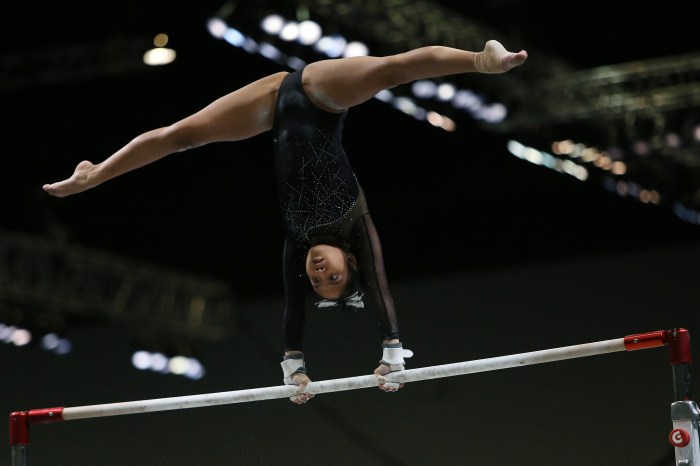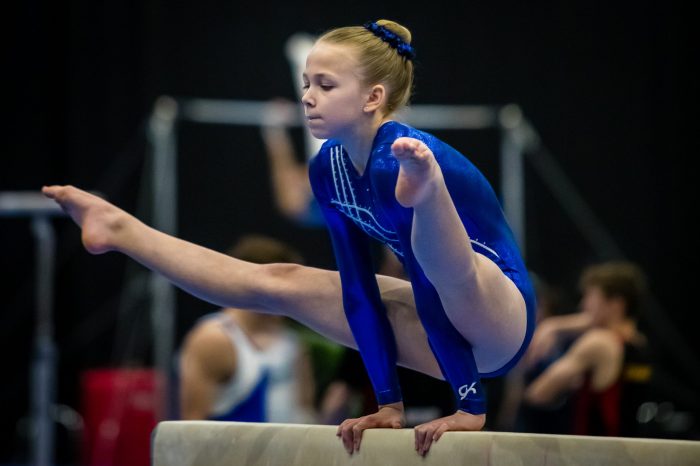Artistic gymnastics, a captivating sport that blends athleticism, artistry, and elegance, invites us into a realm where the human body becomes an instrument of awe-inspiring feats.
From the gravity-defying vaults to the breathtaking dismounts, artistic gymnastics is a testament to the pinnacle of human physical prowess and artistic expression.
Artistic Gymnastics: Overview
Artistic gymnastics is a sport that combines strength, flexibility, and coordination. Gymnasts perform a series of acrobatic maneuvers on various apparatus, including the vault, uneven bars, balance beam, and floor exercise. The sport requires a high level of physical fitness and mental focus.The origins of artistic gymnastics can be traced back to ancient Greece, where gymnasts performed exercises to prepare for military training.
The sport was formalized in the 19th century and became an Olympic event in 1896. Today, artistic gymnastics is one of the most popular sports in the world, with millions of participants worldwide.
Techniques and Skills
Artistic gymnastics requires a variety of fundamental techniques and skills, including:
- Strength: Gymnasts need to be strong to perform the demanding maneuvers required in the sport.
- Flexibility: Gymnasts need to be flexible to perform the contortions and movements required in the sport.
- Coordination: Gymnasts need to be coordinated to perform the complex maneuvers required in the sport.
In addition to these fundamental techniques, gymnasts also need to master a variety of gymnastic maneuvers, such as handstands, cartwheels, and somersaults. These maneuvers are used to create the routines that gymnasts perform in competition.
Training and Preparation, Artistic gymnastics
Artistic gymnastics requires a rigorous training regimen. Gymnasts typically train for several hours each day, honing their skills and preparing for competition.Coaches play a vital role in the development of gymnasts. They provide instruction, motivation, and support. Nutrition is also important for gymnasts, as they need to fuel their bodies for the demands of training and competition.Mental preparation is also important for gymnasts.
They need to be able to focus and perform under pressure. Gymnasts also need to be able to overcome physical and psychological challenges.
Competition and Judging

Artistic gymnastics competitions are held at various levels, from local to international. The most prestigious competition is the Olympics, which is held every four years.Gymnasts are judged on their technical skills, artistry, and difficulty of their routines. The judges use a 10-point system to score each routine.The rules and scoring system for artistic gymnastics are complex and have evolved over time.
The current rules are designed to encourage gymnasts to perform difficult and innovative routines.
Notable Gymnasts and Achievements

There have been many notable gymnasts throughout history. Some of the most famous include:
- Nadia Comaneci: The Romanian gymnast was the first to score a perfect 10 at the Olympics.
- Simone Biles: The American gymnast is one of the most decorated gymnasts in history.
- Li Ning: The Chinese gymnast is one of the most successful male gymnasts in history.
These gymnasts have all made significant contributions to the sport and have inspired generations of gymnasts.
Impact and Benefits
Artistic gymnastics has a number of positive benefits, including:
- Physical health: Artistic gymnastics helps to improve strength, flexibility, and coordination.
- Mental health: Artistic gymnastics helps to improve focus, concentration, and self-confidence.
- Educational opportunities: Artistic gymnastics can help to develop important life skills, such as teamwork, discipline, and perseverance.
- Career opportunities: Artistic gymnastics can lead to a variety of career opportunities, such as coaching, teaching, and sports administration.
Artistic gymnastics is a great way to improve your physical and mental health. It is also a fun and challenging sport that can be enjoyed by people of all ages.
Wrap-Up

As the applause fades and the spotlight dims, artistic gymnastics leaves an indelible mark, not only on the hearts of spectators but also on the lives of those who dare to embrace its challenges.
It is a sport that not only sculpts bodies but also forges unyielding spirits, inspiring us to push the boundaries of what is possible.
General Inquiries: Artistic Gymnastics
What is the difference between artistic and rhythmic gymnastics?
Artistic gymnastics focuses on strength, flexibility, and coordination, while rhythmic gymnastics incorporates elements of dance and uses hand-held apparatus such as ribbons, balls, and hoops.
What are the different events in artistic gymnastics?
For men, events include floor exercise, pommel horse, rings, vault, parallel bars, and high bar. For women, events include floor exercise, vault, uneven bars, balance beam, and rhythmic gymnastics.
How do gymnasts train for competitions?
Gymnasts train rigorously, often spending hours each day practicing and perfecting their routines. They focus on strength training, flexibility exercises, and skill drills.